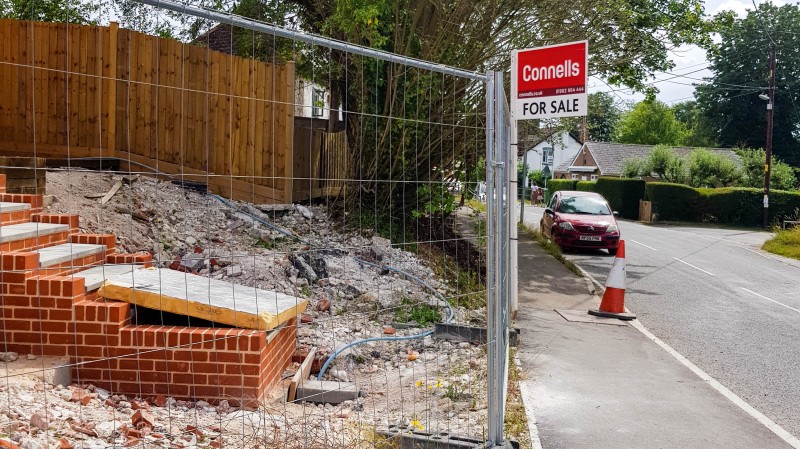You are here: What to consider when building your own house
There is a Grand Designs dream home in all our imaginations, but what if that dream is closer than you think? With soaring rental costs and ever higher asking prices for homes in the UK, many people are looking to self-build as a viable alternative to buying a property.
Hanley Economic Building Society reported a 35% rise in self-build advances during the 18-month period from January 2019 to June 2020 – a sign that more and more people are viewing self-build as a better option than the traditional housing market.
The Government clearly thinks this too – introducing the Right to Build scheme, which gives local government the power to make self-build plots available to self-builders. The Government is hoping to see self-builds boosted from around 13,000 per year currently to around 20,000 a year.
So is it the right approach for you? If you are tired of the escalating costs associated with buying, then weighing up a house build against a house purchase could be a smart decision.

Finding land
Finding a piece of land to build on can be a real challenge. 90% of land in England currently can’t be built on, and land can be incredibly pricey. In some cases, it can make up 50% of your project value. Average land prices vary wildly from location to location – from around £90,000 in the cheapest areas to over £800,000 in others. If you are flexible on your location, you may be able to grab a piece of land at a great price.
Schemes like Right to Build and Serviced Plots are designed to make the land finding process easier. The burden of spending long periods of time (sometimes years) trying to find the right piece of land can be off-putting. But by signing up to the Right to Build register you’ll be notified when land is available. Similarly with serviced plots, you can approach the developer who will tell you what’s available. Be mindful that many of these plots will be brownfield land, so could come with significant de-contamination costs, depending on what the land was previously used for.
Keeping an eye on auction lots and estate agents will help to identify land, but you need to be careful as many will not have planning permission to be built on, especially if it is a greenfield site. You will need to spend time carefully investigating these plots.
Financing your house build or purchase
For a self-build, mortgages tend to be slightly more restrictive than normal, but they are still possible to get hold of. Self-build mortgages are on the increase, but lenders often ask for a higher deposit, as they are lending against a house that doesn’t exist yet, so there is more risk involved. You’ll also likely receive the payments in stages as the development progresses, so you won’t get one lump payment as you would with a traditional house purchase. This can slow down your development and cause cash flow problems, so it is wise to have a healthy contingency fund available to offset the risk of that happening.
You’ll also need to factor in the costs of living somewhere while you are building your new home – and that can mean spending on two properties at the same time.
If this is sounding a little beyond what you might be able to afford, then it is worth noting that with a self-build property there are savings when it comes to stamp duty. You will only pay stamp duty on the land you buy, and only if you spend over £125,000 – that figure goes up to £300,000 if you are a first time buyer. This can help offset any dual living costs while you are building and save money compared with a house purchase.
Living in your self-build or new home
This is where self-build really begins to come into its own. If you are buying a house that already exists, the chances are that you will want to make some significant changes to it so that it suits you, your family and your way of living. It is rare to find a house on the market that is a perfect fit. So if you are considering an extension, loft conversion or other significant works to get a house exactly how you want it, why not consider self-build?
You will get to create the house you want and have a say in every aspect; right down to where the plug sockets go. You will also have peace of mind that everything in your house is up to modern building regulations, electrical standards and energy requirements. There will be no hidden surprises lurking for you under the floorboards or in the walls.
Remember that you will also need to spend time connecting your new house to services and sewers – something an existing house normally has already. While it is not a deal breaker, it can be very expensive and if there are delays or problems with the connections once you are living in the build, it can seriously impact your quality of life. It is best to research these properly before you start building and keep a close eye on the installation to make sure that things run smoothly once you are in.
While a self-build can ultimately give you exactly the house you want, it is a huge logistical operation that involves architects, contractors, planning offices, service connections and the weather. Equally, buying a property can mean you end up living in a home that doesn’t work for you day-to-day and causes aggravation that is not worth it in the long run.
If you are looking to make some home improvements, you may find some of these services useful
Builders
Find local help with a building project
Building Regulations
Find details of local experts who can help with Building Regulations
Architectural Design Services
Find local Architectural Design experts
Structural Inspections
Find an expert to carry out a structural inspection
Building Surveys
I want a local surveyor to do a Building Survey for me
Choose which Architectural service you require
If you are not sure which service you require, check out the options available...


